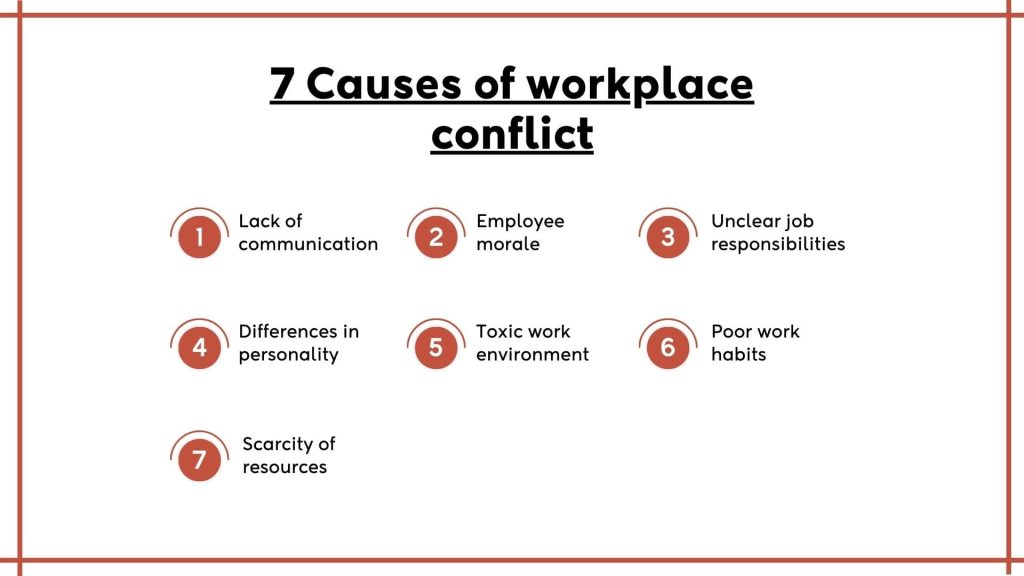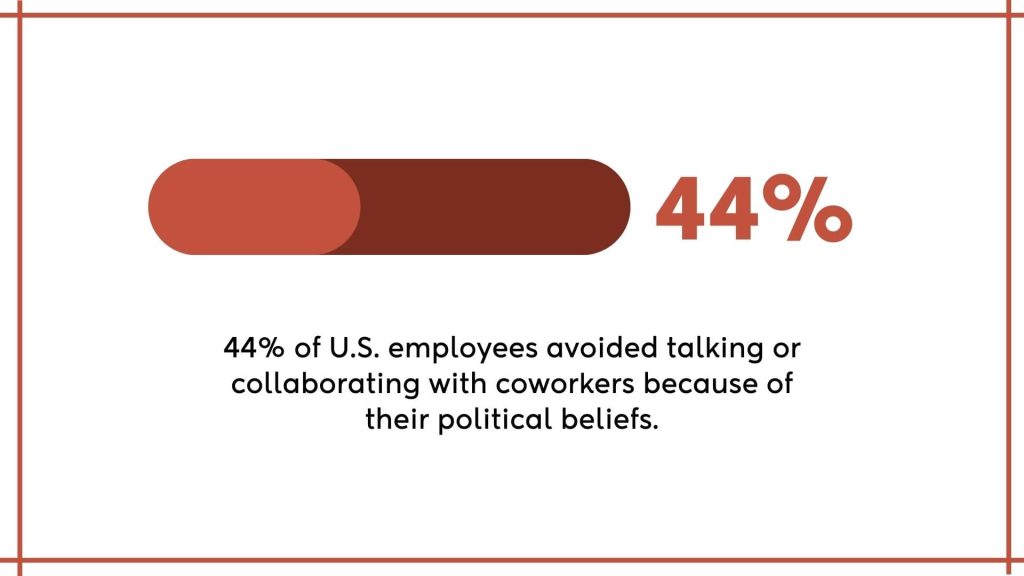According to a recent study, an overwhelming 85% of employees have faced some form of workplace conflict at some point in their careers.
Have you ever faced any conflicts in your workplace?
Personally, I have.
Conflicts are a common occurrence in a workplace that can have damaging effects on both individuals and the company as a whole.
Workplace conflicts can arise from a variety of sources. Being aware of the most significant causes of workplace conflict can help us address issues before they become more serious and damaging.
In this article, we will discuss the seven biggest causes of workplace conflict and the best ways to resolve them.
7 Causes of workplace conflict – and how to resolve them

1. Lack of communication
According to a report from The Economist Intelligence Unit, “44% of respondents stated that miscommunication has led to project failure or delays in completion.”
The number one reason that leads to misunderstandings and errors is poor communication among team members and managers. These misunderstandings can ultimately cause tension and resentment among employees.
For instance, if a team member fails to communicate critical information to their colleagues, it can lead to wasted time, missed deadlines, and even financial loss for the organization.
Similarly, if a manager does not communicate their expectations clearly to their team, it may result in confusion, frustration, and decreased productivity.
How to avoid it: The key to improving communication is to be a good listener. You have to acknowledge the team’s issues and come up with the desired resolution.
This is possible with continuous feedback about employees’ work and challenges and working together to solve them.
Employees also need timely feedback on their performance to grow and make sure there is no communication gap between the team members and the manager.
Learn how to give constructive feedback to your peers.
2. Employee morale
In the recent turn of events, the COVID pandemic has taken a hit on employee morale. The workplace environment is falling short of innovative ideas and creativity. This has eventually led to causes of workplace conflicts where there is no motivation, excitement, or will to contribute your best.
Employee morale exists where people feel valued and ideas are welcomed, and a set platform to experiment with tasks helps build employee morale. It also depends upon the culture of the organization. Culture should be fun, learning-oriented, and full of opportunities.
How to avoid it: Morale is a key driver of the company’s success. As a manager, you need to take time to listen to the employees’ concerns and voice their appreciation for good work.
Implement suggestions to show you listen to their ideas, speak with your team, maintain eye contact, and give them a chance to contribute to the discussion.
When employees have more opportunities to create, they put effort into brainstorming and finding innovative ways to work. Once employees know what to expect, they do more team-building activities and games to strengthen professional relationships.
3. Unclear job responsibilities
A clear understanding of job responsibilities is important in any workplace. When employees are unsure about what exactly their roles entail, it can lead to confusion and conflict.
Confusion in job responsibilities arises when there is a lack of clarity on who is responsible for what tasks when they should be completed, and how they should be done.
This can create a sense of frustration and tension among colleagues, and ultimately impact the productivity and efficiency of the team.
How to avoid it: It’s good to have some flexibility and willingness to work outside core responsibilities. However, excessive ambiguity can lead to low productivity and burnout among employees.
You need to establish clear job descriptions and communicate them effectively to your employees.
You should consider investing in a project management platform that helps your managers define the tasks, assign responsibilities, and stay on track toward deadlines.
4. Differences in personality

Although we do not expect all team members to be friends, a level of mutual respect is crucial for a healthy workplace culture.
Differences in personalities can often lead to conflicts in the workplace. People have varied temperaments, communication styles, and work habits which can cause friction, especially when working in close proximity.
These differences can cause misunderstandings, and miscommunications and can even escalate into larger issues.
How to avoid it: Typically, a code of conduct covers all the policies related to things like information security and bribery, but it can also help reinforce your company’s values, such as inclusivity and mutual respect.
You should actively work towards building a diverse and inclusive workforce. It will help individuals from different backgrounds, and you’ll minimize in-group and out-group behavior.
5. Toxic work environment
A workplace can soon turn into prison if the employees are stressed, communication is limited, blame game, and harmful, or nasty attitudes and actions. The way people feel about themselves and others greatly impacts their productivity.
If your workplace doesn’t seem to offer any mobility, learning opportunities for advancing your skills or career, or mentorship, they are likely not invested in the growth of their employees.
If your physical health is suffering, with no work-life balance, and all of this is happening regularly, then there are clear signs that you are in a toxic work environment.
How to avoid it: Don’t let conflicts escalate, let your team members know that you are open to hearing them out.
Being a manager you should focus on facts in assessing your team members and never take sides.
Involve in team-building activities where people can spend time together outside of work. Lastly, you can offer training to team members that can add to their skills.
Read Here: How to create a positive work environment
6. Poor work habits
If a team member is often late to work or distracted at work these are enough signs to recognize poor work habits.
Even getting up frequently or drinking 3 cups of coffee before lunch can hardly be disruptive to others. These habits can affect the whole team and spark conflict.
The situation might get worse when this behavior spreads among other employees and undermines the team morale.
How to avoid it: Once you’ve realized the poor work habits, talk to the team members, ask why the habit occurs, and guide them to come up with a solution.
Be prepared to take action, deal with conflicts, always follow up to track the progress of your team members, and express confidence in your success.
After all, a united harmonious team is essential to the growth of your organization.
7. Scarcity of resources
Another cause of conflicts in the workplace is scarcity of resources. When resources are limited and there is competition for them, people may feel stressed and anxious, which can lead to conflicts.
For example, if there is a limited budget for a project, team members may argue over how the funds should be allocated, with each person advocating for their own priorities. This can lead to disagreements and even animosity between team members.
How to Avoid it: When resources are limited, you should make sure that resources are allocated fairly and transparently.
It is important to communicate clearly about how they will be distributed and why certain decisions are being made. This can help to build trust and minimize the perception of favoritism or unfair treatment.
Conclusion
While there can be other causes, these seven can be termed as the primary causes that lead to workplace conflicts. As a project manager, you should recognize these early signs and take the necessary steps mentioned above.
To summarize, managing conflicts in the workplace is crucial for maintaining a healthy work environment. By practicing effective communication, empathy, and professionalism, employees can resolve conflicts constructively and respectfully.
Read more —
- Learn about 13 ways to prevent quite quitting in the workplace.
- The definitive guide for building a high-performing team.
- Lead diverse teams effectively in the workplace with these 7 effective steps.
FAQs
Can conflicts be completely avoided in the workplace?
Conflicts are a natural part of human interaction, but proactive measures can significantly reduce their occurrence and impact. Open communication, clear expectations, and a positive work culture contribute to conflict mitigation.
How should conflicts be addressed when they arise?
Conflicts should be addressed promptly and constructively. Establishing open communication channels, encouraging active listening, and utilizing mediation processes can help resolve conflicts effectively.
What role does leadership play in conflict resolution?
Leadership plays a crucial role in shaping workplace culture. Effective leaders foster open communication, model positive behavior, and address conflicts promptly to create a harmonious work environment.
How can organizations create a culture of continuous improvement to prevent conflicts?
Organizations can cultivate a culture of continuous improvement by providing ongoing training, promoting feedback mechanisms, and regularly reassessing and refining processes to adapt to changing dynamics.




















No Comments